
Trash or Treasure?
Cloudfill
There’s more to our scrap and waste than we think: a lot of the time, the things we throw out still have plenty of potential use. Buildings, especially, are rarely recycled. Once they are torn down, they end up in landfills or dumped outside the city limits. This is where Certain Measures sees room for change. The Berlin-based office for design science wants to breathe new life (and shape) into demolished buildings. They have a workable plan.
Photo: David von Becker
Dein Müll ist mein Material
Rip It Up and Start Again
“Recycling is pretty much dead in construction. Construction waste is simply discarded and new buildings use new, standardised materials. For a waste-free future we need to view such materials not as potential waste, but as a resource for new construction,” Tobias Nolte of Certain Measures explains. To him, usually discarded bits and pieces become valuable raw materials. “Think of it as a radical reversal of design process.
Architects usually start with an idea and then source the necessary materials. Why not start with a bunch of materials instead and then get recommendations on what could be built from these? If there aren’t enough materials for a particular project, our algorithm will automatically come up with a workable compromise.” As an easy analogy, Nolte mentions a half-empty refrigerator. “You might know what you’d like to eat, but there’s only so much in the fridge. The algorithm will determine the best possible solution between my preferences and the available resources. So, the result might not be the perfect sandwich, but it will definitely be a decent approximation.”
Perfect Patchwork
What can we build from all the parts? How do they fit together? In the Futurium Lab, Certain Measures decided to take an entire holiday home apart and scan all its components with the eye of their project, a high-resolution webcam that uses custom software to automatically detect and catalogue all ‘raw materials’. Futurium visitors can use these digital source materials to assemble their very own ‘dacha’. Once they have selected a particular building style, the CloudFill software will piece together the best fit for the available parts. A future home away from home! The design is only limited by the rules of physics and the amount of available materials.
So, if you’ve always enjoyed taking things apart to see how they work, this exhibit is for you. Architectural experience or professional Tetris skills are not required.
The Power of the Cloud
According to Nolte, “a house is just a temporary state of the materials, which makes our CloudFill the opposite of a landfill. People can directly use the old materials in our digital cloud to create a new building. They can search the database; view individual parts; and then decide on the shape of their new dacha.
A video also shows how the database creates the new style from the old materials. The best thing is that this doesn’t even require that they be reworked or further processed. The software simply places them where they fit best. This means that our CloudFill doesn’t deal with recycling per se, but rather with distribution and reuse.”
Nothing Ever Goes to Waste
The main thought behind this is the ‘cradle-to-cradle’ principle, where a product’s (re-)use after its end of life is already factored into the design. It’s an intriguing approach that could also encourage the reuse and repurposing of precious resources in other parts of everyday life. After all, such a searchable ‘database of things’ could prove useful in many other areas.
A new outfit for the weekend? A new smartphone? A tent that’s just left at the festival site? Wasting resources is something that affects all of us. In 2016 alone, Germany generated more than 400 million tons of waste and more than half of this came from construction.
Room for New Ideas
Nolte’s colleague Andrew Witt is already anticipating “a time when we can apply this principle to a whole range of different forms, objects, and problems. Let’s say, someone has broken a vessel or accidentally destroyed something in the house. With our approach, they could extend their creativity to reusing those things and potentially creating entirely new uses for this waste.” Discarded appliances, everyday objects, anything we no longer need… the CloudFill approach turns these things into valuable resources that can potentially be traded down to the last scrap. “I really look forward to the time when we can think about everything from bowls to buildings. Even for the things we might no longer use, someone else will find value.”
Naturally, this will work even better if we already consider the materials’ next life when we design them. Modular homes or smartphones are much easier to disassemble and reuse later on. It’s an encouraging idea and one we need to pursue in order to conserve the treasure that is our finite planet.